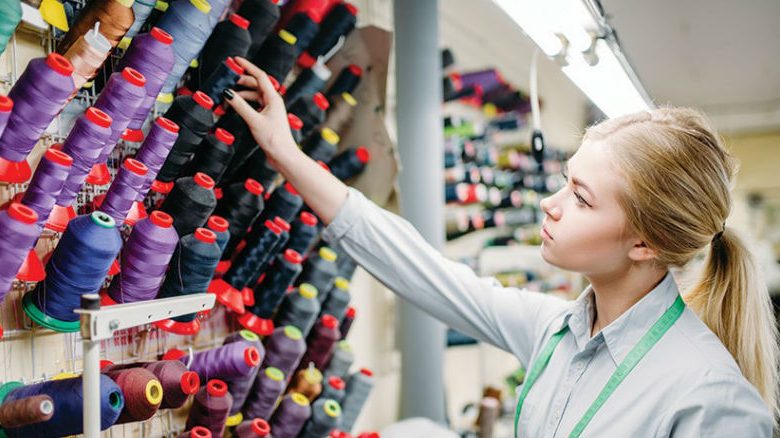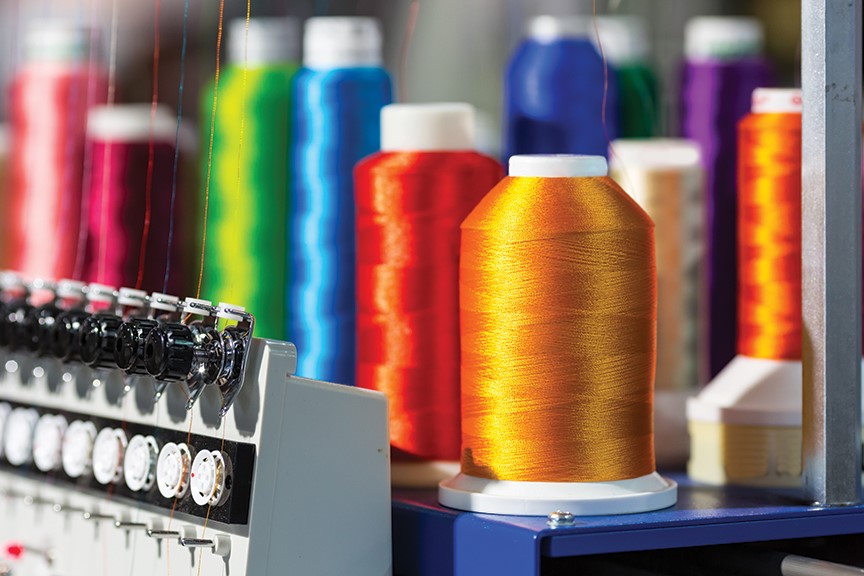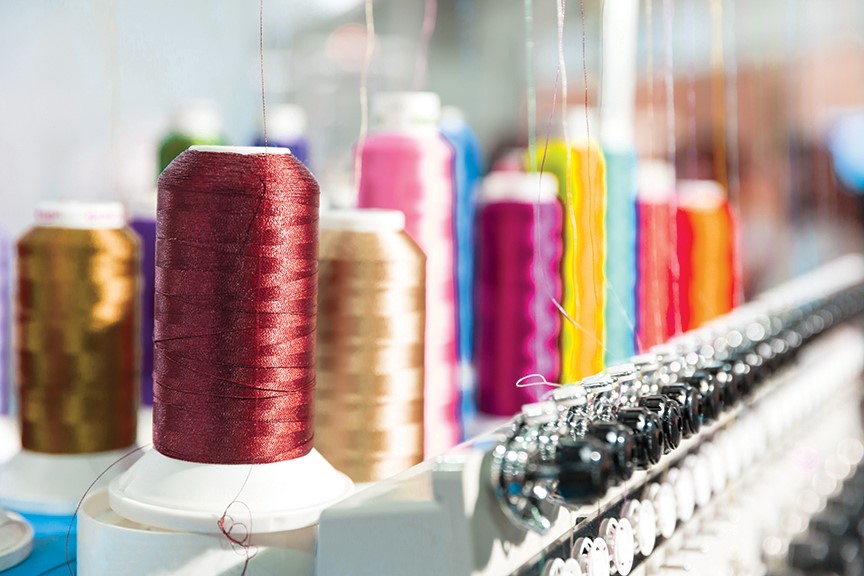Thread Up: Get to Know the Anatomy of Embroidery Thread
There are some qualities of thread to examine before making a choice.

If you ask 10 embroidery operators what the best machine embroidery thread is, it’s entirely possible you’ll get 10 different answers. Some answers will be based on price. Others will be based on lost production time due to thread breaks. A few answers will most likely be inspired by a large stock of a particular thread and the dread of converting colors to those that a switch to another thread would require. One or more people will champion a specific brand of thread because their machine “likes” that brand and runs better than when it’s threaded with other brands.
Determining the “best” brand of embroidery thread depends on a lot of factors and can be complicated by things like the number of stitches in a design, the size of the design elements, the desired look of the finished piece, and the fabric or item onto which the design is being stitched. Deciding the best thread for any individual user is an individual choice, but there are some qualities of a thread that should be examined before that choice is made.
PICK YOUR POISON
One thing to look at when deciding which thread is the best thread for your project is the fiber from which the thread is made. Here are some common fibers and their characteristics.
Polyester: Polyester thread is rapidly replacing rayon as the thread of choice for machine embroiderers. At one time it was less popular because it had less sheen than rayon, but since tri-lobal polyester thread has been introduced, that issue is no longer valid. Tri-lobal polyester thread offers a sheen that rivals rayon while also providing increased colorfastness and durability.
Rayon: Once the most popular choice for machine embroidery, rayon has begun to lose ground to polyester. Rayon was long known for its vibrant shine but cannot match polyester when it comes to durability and colorfastness. Some people choose to use rayon because it has been touted as a natural fiber, which isn’t exactly the case. Rayon is made from viscose, which is wood pulp that has been chemically treated. So, while it technically has an element of nature, the addition of chemical treatment negates much of that designation.
Cotton: Cotton is a natural fiber, which makes it popular for those who are concerned with eco-friendly embroidery. The problem with cotton is the threads are soft and can often be more fragile than more robust threads like polyester. However, cotton provides a matte finish, which is ideal for those who prefer less shine. Quilting thread is often cotton, which has popularity with the quilting community but is less commonly used in machine embroidery.
Silk: Silk thread is not as common as the other threads mentioned, but it does have its place in machine embroidery. Silk thread is generally used for embroidery on specialty fabrics like silk and satin. The durability of silk thread can be a problem, although it is stronger than most people would think. That said, the availability and cost of silk thread may be its largest con.
Metallic: Metallic thread is generally considered an accent thread. One thing that determines the quality of a metallic thread is the core around which the thread is created. Standard cores include polyester, rayon, or nylon. More durable cores, like polyester or nylon, tend to create metallic threads that are less likely to break.

CONSISTENT COLORS
Another important consideration for choosing embroidery thread is the dying process. Many thread manufacturers have recipes for their dyes ensuring that each dye lot is identical. This helps preserve continuity and ensures that shades will not vary from one lot to another. Any embroiderer who has gone through the process of selecting a color with a customer knows why this is important. Consistent dye lots are vital for the success of repeat jobs or even for completion of large jobs where large quantities of garments are being embellished.
Dye practices can also have an impact on the durability of a thread. Instead of scrapping thread lots that were incorrectly dyed, some thread manufacturers will simply dye the thread again using a darker color. Black is a common culprit in cases like this, which is why black may break more often than other colors. Since the thread has been through the dying process twice, it is less durable and more brittle than it would typically be. While all dark color threads are not necessarily re-dyed, it does happen and is something to be aware of when choosing your thread.
LONG LASTING
Many other outside factors affect the longevity, color retention, and workability of thread. This includes how and where it is stored. Sunlight is a huge culprit as UV rays can cause thread color to fade and the thread fibers to dry out and become brittle. This won’t happen with just a bit of exposure to sunlight, but if the thread is consistently exposed to the sun over an extended period, colors will fade, and the thread may become more prone to breaks. It is always best to store your thread in an area that avoids direct sunlight.
Another potential issue that can often affect thread is dust. If your thread is stored near air vents or heating ducts, dust can collect on open spools or cones. Dust may not cause much of an issue for the thread itself as it won’t fade colors or cause dryness, but it can wreak havoc with the workings of your machines. As the thread runs through the machine, the dust is left behind, clogging feeds and generally gumming up the works. Also, storing thread near heating ducts can cause problems as a constant feed of warm air can dry out the thread and cause it to become brittle on top of collecting a layer of dust.
Ideally, all thread should be stored in a closed bin or plastic tub, in a drawer, or a closet. Many thread brands come with plastic coverings which help to keep the thread protected from things like dust when the thread is not in use. Thread should be kept in a room that has a proper level of humidity, too humid and the thread can become sticky or develop mold, not humid enough and the thread can become brittle. Machine embroidery thread should also be protected from direct sunlight, as discussed above. The more you do to protect your thread and store it in the proper conditions, the more likely it is that the thread will be usable for a reasonable length of time.
The main thing to remember when choosing an embroidery thread is that the best thread for you is the one that runs most efficiently and smoothly on your machine. Quality threads are more likely to have consistent dye lots and superior colorfastness and durability. Cheap threads do have more of a tendency to bleed, fade, and shred, which has the potential to cause issues. You should also consider the number of colors that you use regularly. Some thread manufacturers or distributors offer kits with a wide variety of colors. This may, on the surface, look like a good deal, but if you only use a limited number of colors, the rest of the thread will be left to sit, where it can dry out and fade. Having a wide array of color choices seems very appealing, but if you won’t use those colors regularly, you’re better off investing in a more abundant supply of the few colors you use often. It is also wise to factor in lost production time due to thread breaks or any of the issues mentioned here. Any savings accrued by purchasing a less expensive thread can be lost if that thread doesn’t run well and causes production stoppage. Time is money, and any time the machine isn’t running is lost money for your business.

DRY THREAD TESTS
Because we know thread does dry out and can become brittle, it is wise to periodically test cones that have been in use or in storage for a while. The most straightforward test goes by several names including the snap test, the pull test, and the tug test. Essentially, what this test does is show the durability of your thread.
To perform the test, unwind between 6″ and one foot of thread and hold the thread firmly in both hands like you’re performing a mini tug of war. Pull your hands apart until the thread breaks. If the thread is still in good condition, it will snap cleanly. If the thread shreds or pulls apart in a piecemeal fashion, then it’s likely the thread should be thrown out. Thread that shreds is thread that is likely to break often, slowing down production and causing frustration of the machine operator.
This article appears in the May issue of Printwear. Don’t miss out on other industry-focused pieces like this-subscribe today!